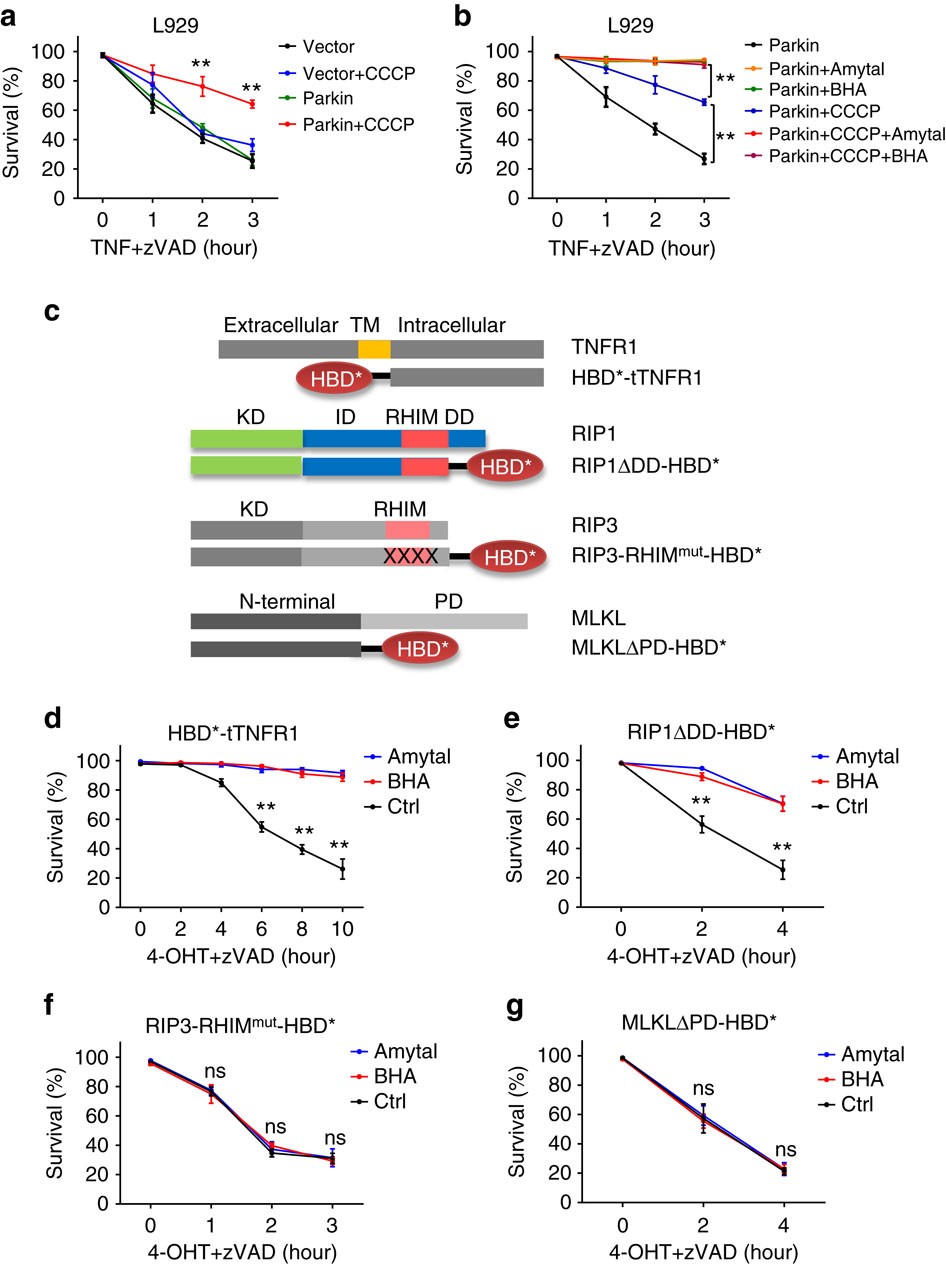当前位置:
X-MOL 学术
›
Nat. Commun.
›
论文详情
Our official English website, www.x-mol.net, welcomes your
feedback! (Note: you will need to create a separate account there.)
RIP1 autophosphorylation is promoted by mitochondrial ROS and is essential for RIP3 recruitment into necrosome.
Nature Communications ( IF 14.7 ) Pub Date : 2017-02-08 , DOI: 10.1038/ncomms14329 Yingying Zhang , Sheng Sean Su , Shubo Zhao , Zhentao Yang , Chuan-Qi Zhong , Xin Chen , Qixu Cai , Zhang-Hua Yang , Deli Huang , Rui Wu , Jiahuai Han
Nature Communications ( IF 14.7 ) Pub Date : 2017-02-08 , DOI: 10.1038/ncomms14329 Yingying Zhang , Sheng Sean Su , Shubo Zhao , Zhentao Yang , Chuan-Qi Zhong , Xin Chen , Qixu Cai , Zhang-Hua Yang , Deli Huang , Rui Wu , Jiahuai Han

|
Necroptosis is a type of programmed cell death with great significance in many pathological processes. Tumour necrosis factor-α(TNF), a proinflammatory cytokine, is a prototypic trigger of necroptosis. It is known that mitochondrial reactive oxygen species (ROS) promote necroptosis, and that kinase activity of receptor interacting protein 1 (RIP1) is required for TNF-induced necroptosis. However, how ROS function and what RIP1 phosphorylates to promote necroptosis are largely unknown. Here we show that three crucial cysteines in RIP1 are required for sensing ROS, and ROS subsequently activates RIP1 autophosphorylation on serine residue 161 (S161). The major function of RIP1 kinase activity in TNF-induced necroptosis is to autophosphorylate S161. This specific phosphorylation then enables RIP1 to recruit RIP3 and form a functional necrosome, a central controller of necroptosis. Since ROS induction is known to require necrosomal RIP3, ROS therefore function in a positive feedback circuit that ensures effective induction of necroptosis.
中文翻译:

线粒体ROS促进RIP1自磷酸化,对于RIP3募集至坏死体至关重要。
坏死病是一种程序性细胞死亡,在许多病理过程中具有重要意义。促炎细胞因子肿瘤坏死因子-α(TNF)是坏死性肝炎的典型触发因素。已知线粒体活性氧(ROS)会促进坏死性坏死,而TNF诱导的坏死性坏死需要受体相互作用蛋白1(RIP1)的激酶活性。然而,ROS如何起作用以及哪些RIP1磷酸化促进坏死病尚不十分清楚。在这里,我们显示RIP1中的三个关键半胱氨酸是检测ROS所必需的,并且ROS随后激活了丝氨酸残基161上的RIP1自磷酸化(S161)。RIP1激酶活性在TNF诱导的坏死性坏死中的主要功能是使S161自身磷酸化。然后,这种特定的磷酸化作用使RIP1能够募集RIP3并形成功能性坏死体,坏死病的中央控制者。由于已知ROS诱导需要坏死性RIP3,因此ROS在正反馈电路中起作用,以确保有效诱导坏死性肾病。
更新日期:2017-02-10
中文翻译:

线粒体ROS促进RIP1自磷酸化,对于RIP3募集至坏死体至关重要。
坏死病是一种程序性细胞死亡,在许多病理过程中具有重要意义。促炎细胞因子肿瘤坏死因子-α(TNF)是坏死性肝炎的典型触发因素。已知线粒体活性氧(ROS)会促进坏死性坏死,而TNF诱导的坏死性坏死需要受体相互作用蛋白1(RIP1)的激酶活性。然而,ROS如何起作用以及哪些RIP1磷酸化促进坏死病尚不十分清楚。在这里,我们显示RIP1中的三个关键半胱氨酸是检测ROS所必需的,并且ROS随后激活了丝氨酸残基161上的RIP1自磷酸化(S161)。RIP1激酶活性在TNF诱导的坏死性坏死中的主要功能是使S161自身磷酸化。然后,这种特定的磷酸化作用使RIP1能够募集RIP3并形成功能性坏死体,坏死病的中央控制者。由于已知ROS诱导需要坏死性RIP3,因此ROS在正反馈电路中起作用,以确保有效诱导坏死性肾病。


















































 京公网安备 11010802027423号
京公网安备 11010802027423号